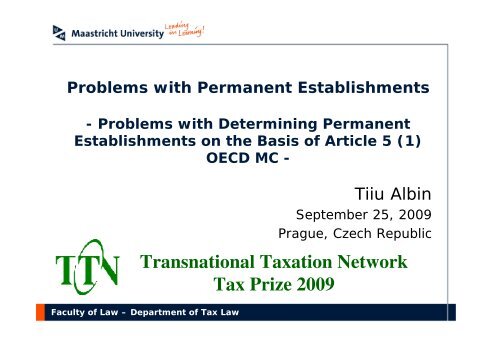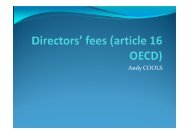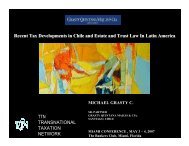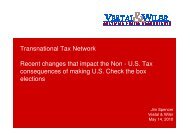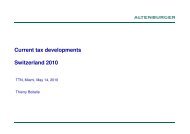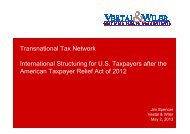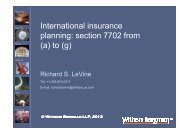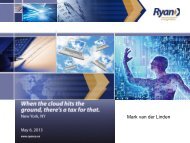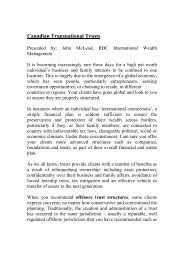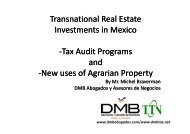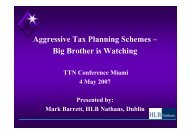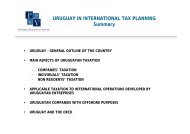Problems With Permanent Establishments - TTN Transnational ...
Problems With Permanent Establishments - TTN Transnational ...
Problems With Permanent Establishments - TTN Transnational ...
You also want an ePaper? Increase the reach of your titles
YUMPU automatically turns print PDFs into web optimized ePapers that Google loves.
<strong>Problems</strong> with <strong>Permanent</strong> <strong>Establishments</strong><br />
- <strong>Problems</strong> with Determining <strong>Permanent</strong><br />
<strong>Establishments</strong> on the Basis of Article 5 (1)<br />
OECD MC -<br />
Tiiu Albin<br />
September 25, 2009<br />
Prague, Czech Republic<br />
<strong>Transnational</strong> Taxation Network<br />
Tax Prize 2009<br />
Faculty of Law – Department of Tax Law
A <strong>Permanent</strong> Establishment? (1)<br />
Application:<br />
• Domestic laws<br />
• Ca 100 years ago<br />
• International law<br />
• Bilateral/multilateral double-tax treaties<br />
•EC law<br />
• EC Treaty<br />
•Directives<br />
• Parent-Subsidiary Directive<br />
• Interest-Royalty Directive<br />
• Merger Directive<br />
Faculty of Law – Department of Tax Law
A <strong>Permanent</strong> Establishment? (2)<br />
Purpose:<br />
⇒ Allocation of taxing powers<br />
⇒ Provision of legal certainty<br />
Definition:<br />
“A fixed place of business through which the<br />
business of an enterprise is wholly or partly carried<br />
on.” (Article 5 (1) OECD MC, 2008)<br />
Faculty of Law – Department of Tax Law
I Condition – A Place of Business (1)<br />
• All physical objects – tangible assets (OECD Comm. on Article 5 para. 4)<br />
– Premises<br />
– Facilities<br />
– Installations<br />
–Assets<br />
–Equipment<br />
– Accessories<br />
• Used by a taxpayer<br />
• Wholly or partly<br />
• Commercially necessary<br />
• Economic activity of the taxpayer<br />
• But:<br />
• Mobile places?<br />
• Legal title of the place?<br />
• Participation in corporation, claims, intangible property<br />
rights, operation of assets, etc?<br />
Faculty of Law – Department of Tax Law
I Condition – A Place of Business (2)<br />
• “Virtual places of business”?<br />
–OECD’s approach<br />
• Tangible computer equipment<br />
• Intangible software & data<br />
–VCLT’sapproach<br />
• Articles 31 & 32 – “ordinary meaning”<br />
– Unilateral approach<br />
• Functions performed through that place<br />
Faculty of Law – Department of Tax Law
Services PE<br />
–Why?<br />
• Source State’s taxing rights<br />
• Similar treatment of business activities<br />
– A Broad Concept?<br />
• Flexibility in deeming a PE to exist<br />
– Article 14 OECD MC?<br />
• Independent personal services<br />
Faculty of Law – Department of Tax Law
Services PE<br />
– Presence vs. Performance of individual<br />
• 183 days vs. 10 days<br />
– Number of contracts/clients<br />
• 1 client<br />
– Performance vs. Consumption of services<br />
• State S vs. State R/3 rd State<br />
– Determination of gross revenue<br />
• Domestic laws<br />
– % of entity’s gross revenue<br />
Faculty of Law – Department of Tax Law
II.a Condition – Geographical Permanence<br />
• Specific geographical location<br />
– Link between the place and geographical point<br />
• Nature of Business?<br />
– E.g. telecommunication services<br />
• Commercial and geographical coherence? (OECD Comm.<br />
On Article 5 paras. 5.1-5.4 & 6)<br />
– Size of the place?<br />
– Mobile activities?<br />
• Locations are neighboring, and<br />
• Same business activities<br />
– One vs. several PEs<br />
Faculty of Law – Department of Tax Law
II.b Condition – Temporal Permanence<br />
• Existence vs. Usage?<br />
• Intention of taxpayer<br />
• Nature of activity?<br />
• Sufficient time?<br />
– 4 months vs. 4 years<br />
• Frequent activity?<br />
• Aggregation of time?<br />
• Time vs. Number of deals<br />
Faculty of Law – Department of Tax Law
III Condition – Disposition<br />
• A(-n) (independent) condition?<br />
• Wide or broad interpretation?<br />
• Legal right?<br />
– Illegal disposition (OECD Comm. on Article 5 para. 4.1)<br />
– Implicit authorization (factual right to use)<br />
• Really?<br />
– Factual use is an additional condition to the formal right<br />
• Control vs. presence?<br />
Faculty of Law – Department of Tax Law
IV Condition – Carry on Business of the<br />
Enterprise through that Place (1)<br />
• Whose business (is carried on)?<br />
– Employees?<br />
–Subcontracting?<br />
• Construction-clause PE (OECD Comm. on Article 5 para. 19)<br />
• Responsibility assumed by the main<br />
contractor?<br />
• Attribution of profits to the PE?<br />
• Which connection (exists between the place and<br />
business)?<br />
Faculty of Law – Department of Tax Law
IV Condition – Carry On Business of the<br />
Enterprise through That Place (2)<br />
• Active or passive business?<br />
– “Carry on”<br />
– Purpose of Article 7 OECD MC<br />
• Vs. Articles 10-13 OECD<br />
• Productive character of activity?<br />
– Mexico/London MCs – YES!<br />
–OECD/UN MCs –NO!<br />
• Business has only expenditures?<br />
Faculty of Law – Department of Tax Law
Conclusions<br />
• Lack of consistency between States<br />
– Flexible definition<br />
– Double-(non-)taxation<br />
• Erosion of concept?<br />
– Substantial entrepreneurial activities<br />
Faculty of Law – Department of Tax Law
Suggested Literature<br />
• OECD Model Tax Convention on Income and Capital and Commentary (2008).<br />
• OECD Report, ‘The Tax Treaty Treatment of Services: Proposed Commentary Changes’<br />
8 December 2006, , accessed 21<br />
January 2009.<br />
• Caridi, A, ‘Proposed Changes to the OECD Commentary on Article 5: Part I - The<br />
Physical PE Notion’ (2003) 43 European Taxation 8-20.<br />
• Còrabi, G, ‘<strong>Permanent</strong> Establishment: A Historical Analysis through Model<br />
Conventions’, (2000) 27 Tax Planning International Review 23-38.<br />
• Hamad, A, ‘Rationalising the "<strong>Permanent</strong> Establishment’ (2006) 35 Australian Tax<br />
Review 52-83.<br />
• Herbrich, Dietmar, ‘The Future of Taxing Business Profits’ in Markus Stefaner, Mario<br />
Züger (eds), Tax Treaty Policy and Development (39 Series on International Tax Law,<br />
Linde Verlag, Vienna 2005) 329-349.<br />
• Skaar, A, Commentary on Article 5 of the Model Treaty: The Concept of <strong>Permanent</strong><br />
Establishment (PE, 25 Supplementary, IBFD, Amsterdam 2005).<br />
• Skaar, A, <strong>Permanent</strong> Establishment. Erosion of a Tax Treaty Principle (13 Series of<br />
International Taxation, Kluwer Law and Taxation Publishers, Deventer 1991).<br />
• Tadmore, N, ‘Clicks vs. Bricks: The Interaction between the OECD PE Concept And Web<br />
Sites’ (2001) 22 Tax Notes International 1821-1831.<br />
• Vogel, K, Klaus Vogel on Double Tax Conventions (3rd edition, Kluwer Law<br />
International, London 1997).<br />
Faculty of Law – Department of Tax Law
Many Thanks!<br />
Tiiu Albin LL.M<br />
Junior Researcher<br />
Tax Law Department, Faculty of Law<br />
Maastricht University<br />
tiiu.albin@maastrichtuniversity.nl<br />
www.maastrichtuniversity.nl<br />
Faculty of Law – Department of Tax Law


